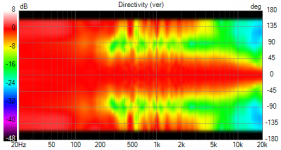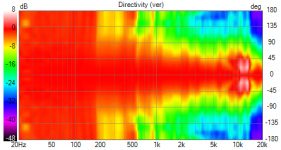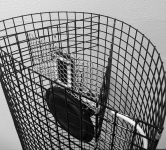I used to think so but it seems to sound great everywhere in my room and there are no dropout null positions.
GRS planars in EU https://www.soundimports.eu/en/brands/grs/
But then you must decide if you will use these large planars all the way up - with increaseing directivity. Planar tweeters are more common, also without backplate. Then dimensions and frame width become a factor...
With dipoles frontside radiation smoothness is most important, but rearside should have almost same total spl, to give late reflections, to give same tonality through the spectrum in a room.
Bad example vs. good example
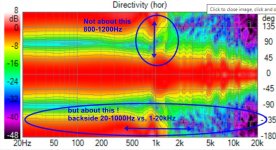
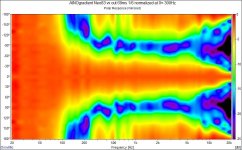
But then you must decide if you will use these large planars all the way up - with increaseing directivity. Planar tweeters are more common, also without backplate. Then dimensions and frame width become a factor...
With dipoles frontside radiation smoothness is most important, but rearside should have almost same total spl, to give late reflections, to give same tonality through the spectrum in a room.
Bad example vs. good example


Last edited:
Last edited:
That's why my measurements of the Scanspeak 12MU let assume that it could be a really good solution for the upper midrange (see here: https://www.diyaudio.com/community/threads/purifi-drivers-for-open-baffle.390740/post-7134793) up to 2kHz and a little bit beyond. I wonder, what the reason for the good performance on the rear side is. Magnet size or magnet shape or something else?With dipoles frontside radiation smoothness is most important, but rearside should have almost same total spl, to give late reflections, to give same tonality through the spectrum in a room.
Or, meanwhile listed, not yet in stock:Good dipole symmetry above 2kHz can be obtained only with planar drivers. Magnetostatics are reasonable price, but availability and unit variance have been questionable.
In EU eg. TLHP has https://en.toutlehautparleur.com/wi...sducer-radian-lm8k-7-ohm-3-5-x-7-87-inch.html
https://en.toutlehautparleur.com/br...er-radian-lm10n-6-8-ohm-125-8-x-254-8-mm.html
Can maybe used up to 2kHz or higher, though the horizontal directivity already widens a bit at 1500Hz.
I'm very curious how it performs distorsion wise.
Thanks a lot for the measurements.There is ONE cone type driver that I have found can be used above 2kHz, and that is the SB Acoustics SB17MFC.
I wonder, why this one looks better than most others.
The driver itself does not look extraordinary. No special basket, typical magnet size, not really small.
However, front/rear response similarity looks quite acceptable ..
Even the very special design of the Accuton C90-6-724 does not deliver a better front/rear response similarity:
https://hifi-selbstbau.de/datenbler-mainmenu-40/tiefmittelt-mainmenu-58/462-accuton-c90-6-724
(German page, scroll down and search for the graph "Accuton C90-6-724 (1V); Schalldruck 0° (vorn/hinten)")

https://hifi-selbstbau.de/datenbler-mainmenu-40/tiefmittelt-mainmenu-58/462-accuton-c90-6-724
(German page, scroll down and search for the graph "Accuton C90-6-724 (1V); Schalldruck 0° (vorn/hinten)")
Last edited:
I haven't saved all my measurements, but you can't guess normal midrange's rearside dispersion just by looking!
I have B&G planars, which are basically same as GRS. Distortion below 800Hz with dipole eq is high. Crossover slope and F must be tested. Above 1khz distortion is pretty good even well above 100dB/2m
I believe, that it is worth trying to mate a small mid like SS 12MU with 3-inch planar tweeter, xo around 2kHz! Remember that a small mid in minimal baffle as dipole will distort heavily below say 300Hz.
Indoor measurement, LR2 xo around 1kHz and 4kHz. B&G 8 and 3
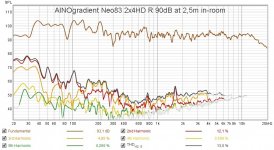
I have B&G planars, which are basically same as GRS. Distortion below 800Hz with dipole eq is high. Crossover slope and F must be tested. Above 1khz distortion is pretty good even well above 100dB/2m
I believe, that it is worth trying to mate a small mid like SS 12MU with 3-inch planar tweeter, xo around 2kHz! Remember that a small mid in minimal baffle as dipole will distort heavily below say 300Hz.
Indoor measurement, LR2 xo around 1kHz and 4kHz. B&G 8 and 3

Last edited:
Back to the use of Purifi drivers:
If we see the measurements from @CharlieLaub in #38, we can assume, that it makes sense to lowpass the PTT6.5 somewhere below 2kHz, let's say maybe 1.5-1.8kHz.
Which (dipole) tweeter are available, allowing such a low xover frequency with low distortion?
I'm only aware of
Not sure, if some BG Neo 8 or the corresponding GRS driver are able to play up to 20kHz.
Anything else?
If we see the measurements from @CharlieLaub in #38, we can assume, that it makes sense to lowpass the PTT6.5 somewhere below 2kHz, let's say maybe 1.5-1.8kHz.
Which (dipole) tweeter are available, allowing such a low xover frequency with low distortion?
I'm only aware of
- Dayton AMTPro-4
- Mundorf 27D1.1
- ESS Heil AMT
- Beyma TPL-150/TPL-200
Not sure, if some BG Neo 8 or the corresponding GRS driver are able to play up to 20kHz.
Anything else?
Thanks a lot for the measurements.
I wonder, why this one looks better than most others.
The driver itself does not look extraordinary. No special basket, typical magnet size, not really small.
[SB17MFC image]
However, front/rear response similarity looks quite acceptable ..
I had a pair of these drivers from an OB project I did in 2013 (?) but at the time I was not really doing veyr extensive off axis measuring, and definitely not thinking about what was going on to the rear. At some point around 2018 I started measuring lots of drivers, and thinking about trying to get a dipole response over the entire audio band. This means the driver's rear response is just as important as the front. So I started measuring all the drivers I had in my cache (in a nude configuration) and then buying many other drivers when I thought one was promising. So I measured the MFC and then wanted to see if "better" drivers from the same SB17 line would be an improvement. So I bought the NFC, CRC, and CAC versions. All displayed a less friendly response around the dipole peak and above, with flaws that would have made it more difficult to use. Only the CAC version had better distortion performance, but only slightly. So in the end I used the MFC in the project that I wrote up and submitted to audioXpress. It's probably the best sounding speaker I ever designed. I have it set up next to a similar speaker that uses the Satori MW19TX, which is larger and can play lower but has a more problematic response and increasing directivity around 2kHz that necessitates a larger and relatively expensive ($320ea) planar tweeter (Aurum Cantus AST25120, mounting frame removed) crossed at 1.7kHz. In terms of sound the MFC system is slightly better overall. The only other contender at this point is the Purifi PTT6.5M, which will have better distortion performance but it doesn't have as smooth response around the dipole peak that the MFC has when used nude so I will still use the expensive tweeter. The MFC is just a great driver for this application - why pay more?
simple, Polypropylene do wonder .....look at AudioTechnology tooThanks a lot for the measurements.
I wonder, why this one looks better than most others.
The driver itself does not look extraordinary. No special basket, typical magnet size, not really small.
View attachment 1136554
However, front/rear response similarity looks quite acceptable ..
So I measured the MFC and then wanted to see if "better" drivers from the same SB17 line would be an improvement. So I bought the NFC, CRC, and CAC versions. All displayed a less friendly response around the dipole peak and above, with flaws that would have made it more difficult to use. Only the CAC version had better distortion performance, but only slightly. So in the end I used the MFC in the project that I wrote up and submitted to audioXpress. It's probably the best sounding speaker I ever designed. I have it set up next to a similar speaker that uses the Satori MW19TX, which is larger and can play lower but has a more problematic response and increasing directivity around 2kHz that necessitates a larger and relatively expensive ($320ea) planar tweeter (Aurum Cantus AST25120, mounting frame removed) crossed at 1.7kHz. In terms of sound the MFC system is slightly better overall. The only other contender at this point is the Purifi PTT6.5M, which will have better distortion performance but it doesn't have as smooth response around the dipole peak that the MFC has when used nude so I will still use the expensive tweeter. The MFC is just a great driver for this application - why pay more?
The MFC Indeed has a buttery smooth response, but still marred by the blip above 1Khz on a baffle. Did you have that in your measurements?
I wonder if the cone geometry is responsible for the smooth rear response.
The thing about the Purifi is that the W… perhaps even the even M series 6.5TT is good enough down to 120Hz in dipole…
Looking forward to seeing your article in AP. Is it coming next month?
Last edited:
@tktran303 I don't use a baffle (at all), therefore no "blip" around 1kHz. See attached pic. The article should be out in April I think. Pub date has not yet been 100% finalized by the publisher.
Attachments
It might not be the the aesthetic optimum, but couldn't it be a solution to improve the front/rear frequency response similarity by - if two drivers are available per side - flipping one driver, so that the magnet is on the front side of the baffle instead of using a MTM configuration?@Matty I did some measurements of the PTT midrange in the late fall, with the driver nude and suspended above the ground by about 2.5m and measurements done at 0.5m. I measured a few angles from front and rear sides. These are attached. I have also included a plot that compared the "on axis" curves taken in front of (0 deg), and behind (180 deg) the driver. The directivity is relatively stays controlled both in front and back, but overall the response families are different. To the rear the responses all fall off faster above about 1.7kHz compared to in front of the driver. It's not a big deal, but as a result I will cross over to the tweeter around there. If you cross over higher than this and use the front response as a basis for your response, there will be a bit of a hole to the rear up to about 6dB deep. The other area that needs careful attention is the peak around 1.3kHz since it is relatively "peaky" and likely not simple to flatten out.
Like this:
The average of both should still look quite good up to 2Khz or more and will be the same on both sides.
With the mentioned SB drivers it will even be still quite cheap to use this as an MMTMM configuration with the outer drivers turned around.
Last edited:
That would work up to a point, but might already have some vertical lobing problems by 2kHz... and would put the tweeter farther away from one of the drivers. In a dipole MTM configuration or variants of that there is the magnet to worry about, and it will diffract the tweeter output - this will probably be worse as frequency increases above 2kHz. So, all sounds good on paper but in reality you might just be causing new problems. Like you said the SB17MFC is not expensive. You could buy two and try the MTM config with one driver reversed and a tweeter in between. Make some careful high resolution measurements and see if it works.
Following this thread closely as well as the development of 10 inch Purifi. Hoping it will be possible to make a compact 10+5+1 inch OB with Purifi woofers and Mundorf AMT23D6.1-C (with sealed subwoofers below 60-70 hz). Wishful thinking?
Last edited:
^hi, that 10" driver has roughly half Sd of a 15" driver, but xmax seems to be around 15mm which is roughly double to typical 15" driver. Given both were on same sized panel they get about as loud as they have similar volume displacement capability. From this we can estimate one needs as many of those as 15" drivers for same max SPL output. They would most likely have less distortion though, if it was audible in the first place. Quickly estimating about four per side for party. The bigger the baffle / the less you wanna party, the fewer you need 🙂
Last edited:
Did you make a choice?Back to the use of Purifi drivers:
If we see the measurements from @CharlieLaub in #38, we can assume, that it makes sense to lowpass the PTT6.5 somewhere below 2kHz, let's say maybe 1.5-1.8kHz.
Which (dipole) tweeter are available, allowing such a low xover frequency with low distortion?
I'm only aware of
Which else could fit?
- Dayton AMTPro-4
- Mundorf 27D1.1
- ESS Heil AMT
- Beyma TPL-150/TPL-200
Not sure, if some BG Neo 8 or the corresponding GRS driver are able to play up to 20kHz.
Anything else?
Imho the Beyma isn’t so much better to justify the price difference to the AMT4PRO. The Heil certainly is outstanding, but I would’t XO below 2 kHz. All in common is the „excessive“ vertical beaming. Imho it doesn’t match very well to the character of an OB. Id did some trials with AMT4PRO, even mounted to the Beyma-Horn and didn’t liked it at all.
Finally I ended up with a 8“ cone as midbass from 200-1,2 KHz and two compression drivers with cd-horn mounted front and rear.
- Home
- Loudspeakers
- Multi-Way
- Purifi Drivers for Open Baffle
